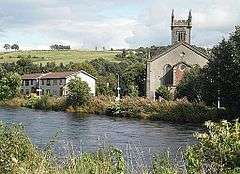Bonhill
| Bonhill | |
| Scottish Gaelic: Both an Uillt | |
| Scots: B'nill | |
 Bonhill parish church, across the River Leven |
|
 Bonhill |
|
| OS grid reference | NS4079 |
|---|---|
| Civil parish | Bonhill |
| Council area | West Dunbartonshire |
| Lieutenancy area | Dunbartonshire |
| Country | Scotland |
| Sovereign state | United Kingdom |
| Post town | ALEXANDRIA |
| Postcode district | G83 |
| Dialling code | 01389 |
| Police | Scottish |
| Fire | Scottish |
| Ambulance | Scottish |
| EU Parliament | Scotland |
| UK Parliament | West Dunbartonshire |
| Scottish Parliament | Dumbarton |
Coordinates: 55°58′59″N 4°34′01″W / 55.983°N 4.567°W
Bonhill (B'nill in Scots and Both an Uillt in Gaelic) is a town in the Vale of Leven area of West Dunbartonshire, Scotland. It is sited on the Eastern bank of the River Leven, on the opposite bank from the larger town of Alexandria.[1]
History
The area is mentioned in a charter of 1225 giving the monks from Paisley Abbey fishing rights on the east bank of the River Leven at the Linbrane pool.[2][3] Bonhill Parish was noted in a charter of 1270 as “the parish of Buthehille”, and the name became Bonyle about 1550, with the variants Bonuil and Bonill appearing before Bonhill was adopted by 1700. In 1650 this small poor parish was enlarged, and since then the Parish has included most of the towns and villages in the Vale of Leven.[4]
The village of Bonhill itself featured an early church, and a ford across the River Leven on the drovers' road to Glasgow. The first modern church was built close to the river in 1747, and it was replaced in 1835 by the present Church of Scotland building on the site of an earlier small church. Various churches of other denominations were constructed from 1830, but closed in the 1960s.[4]
The textile finishing industry came to Bonhill with a printworks, the Dalmonach Works which started in 1786. It burnt down in 1812, and was rebuilt by Henry Bell. A second textile works opened in 1793, and two more works had begun by 1840. Some closed shortly afterwards, but one lasted to 1936. The Dalmonach Works itself featured a school outside the main gates, serving children from the area as well as children employed in the works. After the works closed in 1929, its buildings were used an army barracks during World War II, and subsequently occupied by various smaller companies before the buildings were demolished in 2006, leaving only the school which remains as a listed building.[4]
The town rapidly expanded in the 1960s and 1970s when many residents of Glasgow were moved there when the old slums and tenements were demolished. This process was known as the "Glasgow overspill". The new council run housing schemes were characterised by a high incidence of poverty and unemployment, but the town has changed somewhat with the addition of private housing schemes (such as the Strathleven Park estate) from the late 1970s onwards.
Due to a lack of planning when the new housing was built, Bonhill suffers from a lack of amenities. Most of these are located mainly in Alexandria, just across the river Leven and Dumbarton, 2 miles (3 km) to the South. It serves as a commuter town to Dumbarton and beyond.
According to the 2001 national census, Bonhill's population was 9,574.
Notes
- ↑ "Overview of Bonhill". The Gazetteer for Scotland. 2010. Retrieved 2010-06-28.
- ↑ "Vale of Leven place names Lade to Lynn Walk". Retrieved 2010-06-28.
- ↑ "www.bonhillchurch.com". Retrieved 2010-06-28.
- 1 2 3 "Vale of Leven place names beginning with B". Retrieved 2010-06-28.
| Wikimedia Commons has media related to Bonhill. |